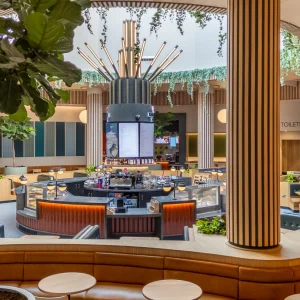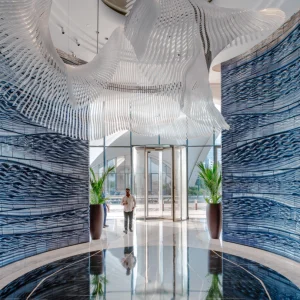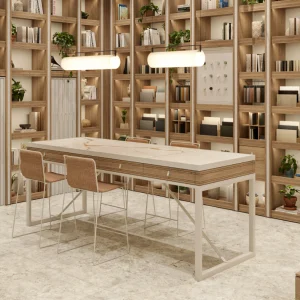Can you pinpoint the thought, whether yours or someone else’s, that led you to a career in design?
For me it was learning to play the drums at six years old and feeling that first sense of creative expression. I got a taste of flow and was hooked. That opened up my mind to the possibility of pursuing creativity that ultimately led to my path of art and design… and music!
In terms of the design and architecture industry, what do you consider the most radical era or pivotal moment?
The iPhone comes along and changes everything. Much like the printing press, all of a sudden we can distribute our view of the world and connect instantly with vast audiences. We are all now hyper-connected broadcasters with 100,000 times more computing power in our hands than the space mission that put man on the moon. This technology has changed almost every sector beyond recognition. The impact is immense.
Which radical thinkers have been inspirations to you in your career?
I think Leonardo da Vinci is unrivalled in terms of radical thinking… from his anatomical studies to pioneering works in cartology, engineering, mathematics – and that’s before painting the most famous painting of all time. This has really inspired me to work across different disciplines and not be pigeon-holed into a single category or genre. I think if you want to push things forward, it’s always better to be the game rather than simply to play it. That way you get to make up the rules!
 Burke says that the Heydar Aliyev Center in Baku, Azerbaijan, is a building that showcases ‘dramatic, sweeping esthetics’. Image Credit: VLADIMIR ZHOGA / www.shutterstock.com
Burke says that the Heydar Aliyev Center in Baku, Azerbaijan, is a building that showcases ‘dramatic, sweeping esthetics’. Image Credit: VLADIMIR ZHOGA / www.shutterstock.com
Who are the radical thinkers who inspire you now?
I think look at indigenous tribes and wisdom traditions such as the Yawanawa people of Brazil or the Huni Kuin of Peru or many of the Native American cultures – those who live in harmony with their environment, use only the resources they need, have a strong connection and reverence to the land, and who weave art, craft and creative expression into everyday life through music, clothing, jewellery, tools and ritual.
Who outside the industry can architects and designers learn from?
I’d wouldn’t say ‘who’ but ‘what’. Nature provides us with the perfect template of sustainability and form and function – all the hallmarks of good design! I believe all the answers we need are staring us in the face – if only we could see them. I’m particularly interested in the research around mycelium networks and fungi’s unique properties as halfway between a plant and animal.
They provide insights for us across carbon cycling, pollutant degradation, health and nutrition, complex networks, building materials, structural engineering and much, much more
What will lead the way for more radical thinking in your/our field?
Bringing more consciousness and awareness to all our actions is essential as we navigate and question what serves us as a collective and what doesn’t – a move away from a ‘growth for growth’s sake’ mentality and individualistic view of the world towards a genuinely connected mentality. From that place, design can build out more essential ways of living to usher us towards a more harmonious existence, one in which balance and restraint provide more equity for all and we tackle global problems collectively – ultimately asking ourselves one critical question: what do we really need?
Could you recommend a book/article/blog that inspired your thinking?
Eckhart Tolle’s The Power of Now. Not an easy or a light read but changes the way you understand yourself and the world around you. Reframed everything for me.
 Vitruvian Man by the ‘unrivalled’ Leonardo da Vinci
Vitruvian Man by the ‘unrivalled’ Leonardo da Vinci
Could you name two buildings/pieces of furniture that you consider radical designs of their time, or perhaps still to this day?
Recently, I’ve gone down an Egyptian pyramids rabbit hole; specifically, the mystery of how they were built. The fact that this is still being hotly debated all these years later just illustrates just how radical the pyramids were. These structures would have been aweinspiring when first but and still are 4,500 years later! The pyramids represent design that boils form down to its absolute essence.
Another example for me is the Heydar Aliyev Center, a building that combines dramatic, sweeping aesthetics with engineering and build techniques that push the limits of what’s possible. Much has been written about Zaha Hadid, from the need for technology to catch up with her ideas, her sustainability focus later in her career, through to her breaking down of norms around the architecture industry at large. This building for me encapsulates much of her legacy, and for me captures a profound sense of balance. I just love it from every angle.
 Burke says his recommended book is ‘not an easy or light read’
Burke says his recommended book is ‘not an easy or light read’
I think best with… My eyes. I tend to see little clues dotted around everywhere which trigger ideas.
I think best… When I least suspect it.
I think best when… I quiet my surroundings down.
The thought that keeps me up at night is… Am I working from a place of truth?
The thought that gets me out of bed each day is… The gratitude of any of this being here in the first place… The magic of life!
Do you like to think with, or think against?
I think against. What are the presumptions we make and the stories we tell ourselves, and within them what can be challenged and rethought? How can I contribute to change?
If you weren’t a designer/architect, where do you think your way of thinking would have led you?
I think probably a musician, pursuing my drumming and love for performing. I’m compelled by the joy of expression and the power of connection through creative thinking, [and also] trying to capture that sense of flow I mentioned above.
 The arrival of the iconic iPhone changed everything, Burke claims
The arrival of the iconic iPhone changed everything, Burke claims
Could you describe radical thinking in three words?
What’s actually real?
What’s the most radical thing you’ve come across today or this week?
I saw Steve Gadd, one of the great drummers of our time, at Ronnie Scott’s Jazz Club. He is one of the most technically gifted musicians in the world – however, this performance was a masterclass in subtlety, restraint and nuance. There’s a big lesson there about doing only what is needed in any given moment. No ego – just less is more, leaving space for everything around to exist in balance.





